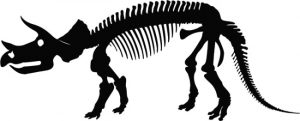 In an age where we’ve made gods out of science and technology, expecting them to give order to our lives and supply us with answers to all life’s questions, it can come as a shock to realise that “there are just some things that we don’t know the answer too – and may never really know for sure“. This question is one of those. That said, some interesting observations can be made.
In an age where we’ve made gods out of science and technology, expecting them to give order to our lives and supply us with answers to all life’s questions, it can come as a shock to realise that “there are just some things that we don’t know the answer too – and may never really know for sure“. This question is one of those. That said, some interesting observations can be made.
The problem with dinosaurs is that they lived a very long time ago- between 250 million and 65 million years ago – and the vast majority of our knowledge of them is based on fossilized bones and skeletons, which are all that have survived the ravages of time.
So, what can we say about whether the dinosaurs are warm or cold-blooded?
Until the 1970s the view that dinosaurs, like other reptiles, were cold-blooded was almost unquestioned. Cold-bloodedness (something of a misnomer) means that an animal has a variable body temperature, which it has to control by external means (such as basking in the sun to warm up). In contrast, warm-blooded animals, such as birds and mammals, maintain a constant body temperature using internal thermoregulation mechanisms.
The orthodoxy, at least until the 1970s, was that dinosaurs, judged by their skeletons, were reptiles. Therefore it was believed (quite without reason, although not necessarily wrongly) that dinosaurs must have been cold-blooded like all the reptiles of today.
However, since the 1970s, some palaeontologists have pointed to a number of factors that suggest dinosaurs may have been warm-blooded after all.
 The Case for Warm Blood
The Case for Warm Blood
 | Unlike modern reptiles, which either crawl or walk with their limbs extended out to the side, one of the main groups of dinosaurs walked with their limbs directly beneath their bodies, like birds and mammals. This ‘fully improved’ stance and gait means that a dinosaur’s posture must have been very like that of a modern running mammal such as a dog. The only animals alive today with the ‘fully erect’ posture of the legs- birds and mammals- are all warm-blooded, suggesting that the dinosaurs must have been warm blooded too. |
| Dinosaurs also had large rib cages that could have held mammal-like hearts and lungs. | |
| Dinosaur bone, like mammal bone, also has more blood-vessels running through it than have the bones of, say, a lizard or a crocodile. These channels exist for rapid blood circulation similar to those found in the bones of warm blooded animals. | |
 | Dinosaurs have long legs. There is not much point in having long legs unless they can be used for fast running. To maintain a high speed over a long distance, however, the animal must produce a great deal of energy, and it must keep on producing it for a long time. It’s suggested that only warm-blooded animals can do that; cold-blooded animals can produce energy quite quickly and they can run quite fast, but only in short bursts. |
 | Some scientists believe that newly hatched dinosaurs could not have kept their body temperature constant, for they were small and naked and, as far as we know, were not kept warm by their parents. If they could not have maintained a constant temperature they could not have been warm-blooded. |
 The Case for Cold Blood
The Case for Cold Blood
 | As previously mentioned dinosaurs, judged by their skeletons, are analogous to modern day reptiles – ergo dinosaurs must have been cold-blooded like all the reptiles of today. |
| The climate was very different in the Mesozoic Era : For all practical purposes, the temperature was the same everywhere on the Earth’s surface.No ice at the poles nor any at the top of the highest mountains. Over the whole planet there was no more than a few degrees difference in temperature. In addition the carbon dioxide levels were 5x the present level. The result is a higher more even temperature making the advantage of being warm-blooded – that is being able to control your own temperature – much less advantageous. | |
 | For an enormous bulky dinosaur it would be easy to keep the temperature of its body fairly constant without having to produce its own body heat and without any outside insulation at all, simply because it is so big. The temperature of the body will indeed go up and down as the surrounding air becomes warmer or cooler, but it will do so very, very slowly; and, if the animal is living in a warm climate that changes very little, then the variations in the animal’s body temperature will be so small as hardly to matter. All this, however, would NOT be true of the many small dinosaurs. |
| Supporters of cold-blooded dinosaurs argue that in the largest dinosaurs a warm-blooded metabolism would be likely to cause internal overheating and immediate death. | |
| No land-dwelling, warm-blooded mammals living today even approach the size of the largest herbivorous dinosaurs (elephants weigh a few tons, max, and the largest terrestrial mammal in the history of life on earth, an Indricotherium, only topped out at 15 to 20 tons). So we have no real precedent to suppose they were warm blooded. |
 The Case for BOTH Cold and Warm Blood
The Case for BOTH Cold and Warm Blood
A recent study by James Gillooly of the University of Florida has developed an equation showing the relationship between body size, body temperature and growth rate of an animal. It concludes that the bigger a dinosaur was, the warmer its blood, suggesting that the question may have no single answer.
So, there you are – WE JUST DON’T KNOW! – and what is more there may not even be a single binary answer – that is some may have been warm blooded and some cold.






You must be logged in to post a comment.